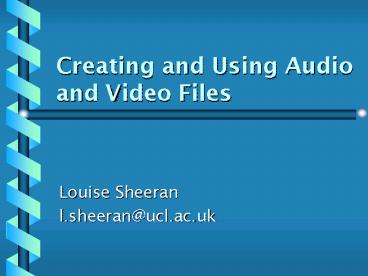Creating and Using Audio and Video Files - PowerPoint PPT Presentation
1 / 18
Title:
Creating and Using Audio and Video Files
Description:
Why use audio and video in language learning exercises? How to digitise audio material ... tucows.mirror.ac.uk. Useful Web sites 2 ... – PowerPoint PPT presentation
Number of Views:95
Avg rating:3.0/5.0
Title: Creating and Using Audio and Video Files
1
Creating and Using Audio and Video Files
- Louise Sheeran
- l.sheeran_at_ucl.ac.uk
2
Overview of Session
- Why use audio and video in language learning
exercises? - How to digitise audio material
- demo followed by a practical session
- How to digitise video material
- Questions/discussion
3
Using Audio and Video in Language Learning
Exercises
- Access to spoken word
- Access to culture
- Supports different types of exercises
- e.g. listening pronunciation
- Students like it
- It adds interest
- Other?
4
Creating an Audio File
- Make an analogue or digital recording
- aim for highest possible quality
- If digital
- transfer file to PC
- If analogue
- transfer to PC
- digitise
- Encode/compress
5
Encoding 1
- Encode the digital file
- Make it smaller!
- Real software digitises and encodes at the same
time
6
Encoding 2
MP3 Encoder
wav file
MP3
wav file or analoge
RealComposer
ra or rm
7
File Formats
- File formats
- Uncompressed
- .wav (standard Windows format)
- Compressed/encoded
- .mp3 (MPEG layer 3 - very popular and versatile)
- .ra (proprietorial RealPlayer format)
8
Your Requirements for Audio
- Audio Card, Speakers/headphones
- Tape recorder, microphone, or existing digital
materials or links to external web sites - Digitisation software (your college or department
may have some) - Encoding (compression) software (MP3 recommended)
- Players (Windows Media, Real, Quicktime, etc.)
9
Your Students Requirements
- Internet Access or CD-ROMs
- Audio card, speakers/headsets
- Players
10
Putting Audio Files on the Web
- Check
- quality
- file format
- size
- Inserting the audio file into the Web page
11
Practical Session
- See handout
- Questions
12
Creating and Using a Video File 1
- Video files much bigger than audio files
- Quality vs. file size is an important issue
- Each clip must suit the application, e.g. lip
synchronisation for pronunciation, size for sub
titles. - Demo of video clips
- If file sizes are large
- consider CD-ROM
- audio only
13
Creating and Using a Video File 2
- Digitisation
- FireWire or Video Capture Card
- Encoding
- Software (e.g. Cleaner 5) or hardware
- Formats
- MPEG1 (video), MPEG3 MP3(audio)
- .rm (Real)
14
Creating and Using a Video File 3
- Players
- Windows Media, Real, Quicktime
- Will all play MP3 (audio) and MPEG1 (video)
- What affects quality?
- Hard disk
- Server
- Processing power
- Network
15
Additional requirements for Video
- FireWire or Video capture card
- Digitisation and encoding software
- Hard disk space
16
Making it work
- Check all pages in both Internet Explorer and
Netscape Communicator - Providing transcriptions for audio and video
files for people with special needs will be a
legal requirement from September
17
Useful Web sites 1
- Netscape Composer
- www.netscape.com
- RealPlayer and RealComposer
- www.real.com
- For more information on the mp3 format and to
download players and encoders - www.mp3.com
- For software in general
- tucows.mirror.ac.uk
18
Useful Web sites 2
- For more information about Microsofts players
and encoders - www.microsoft.com































